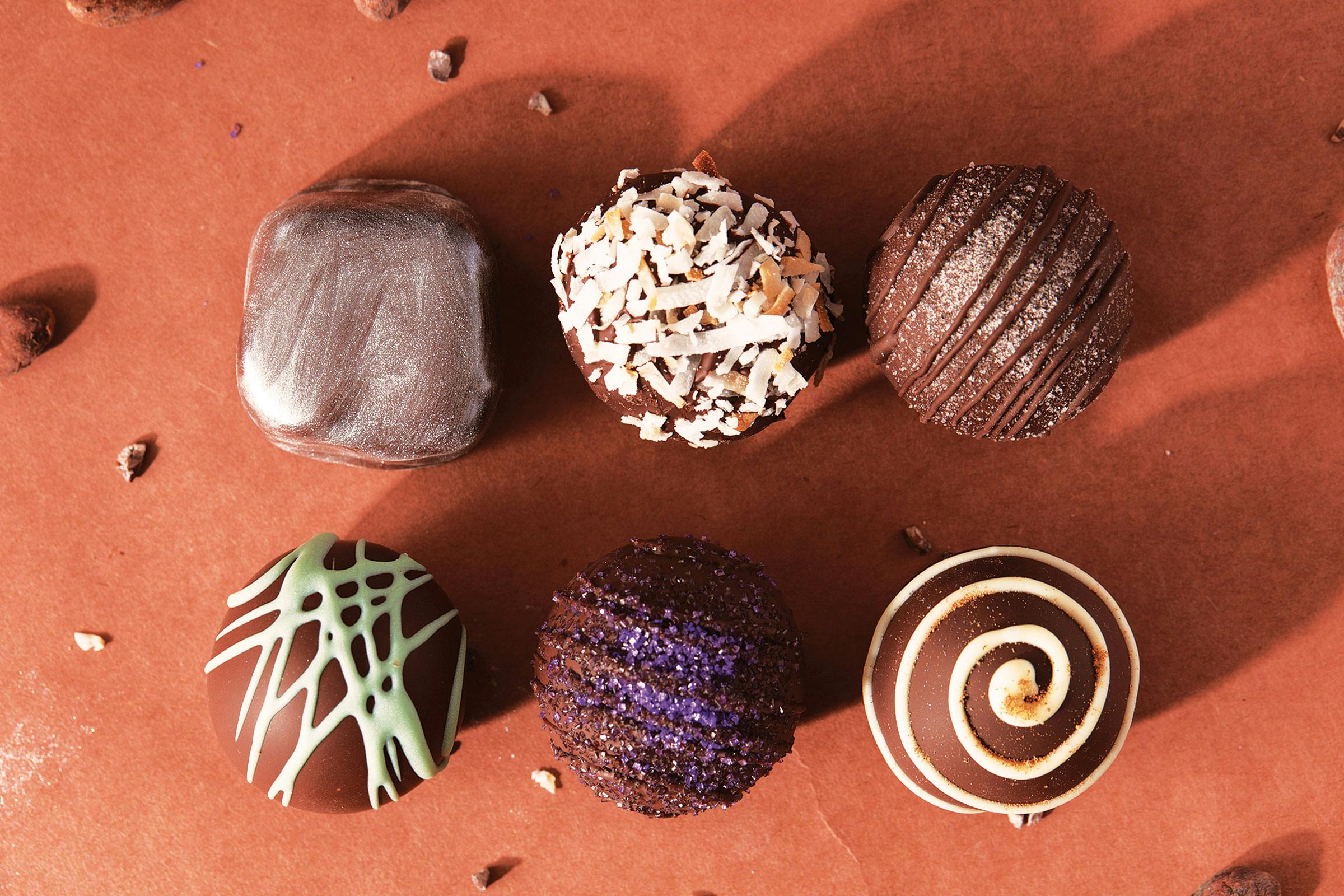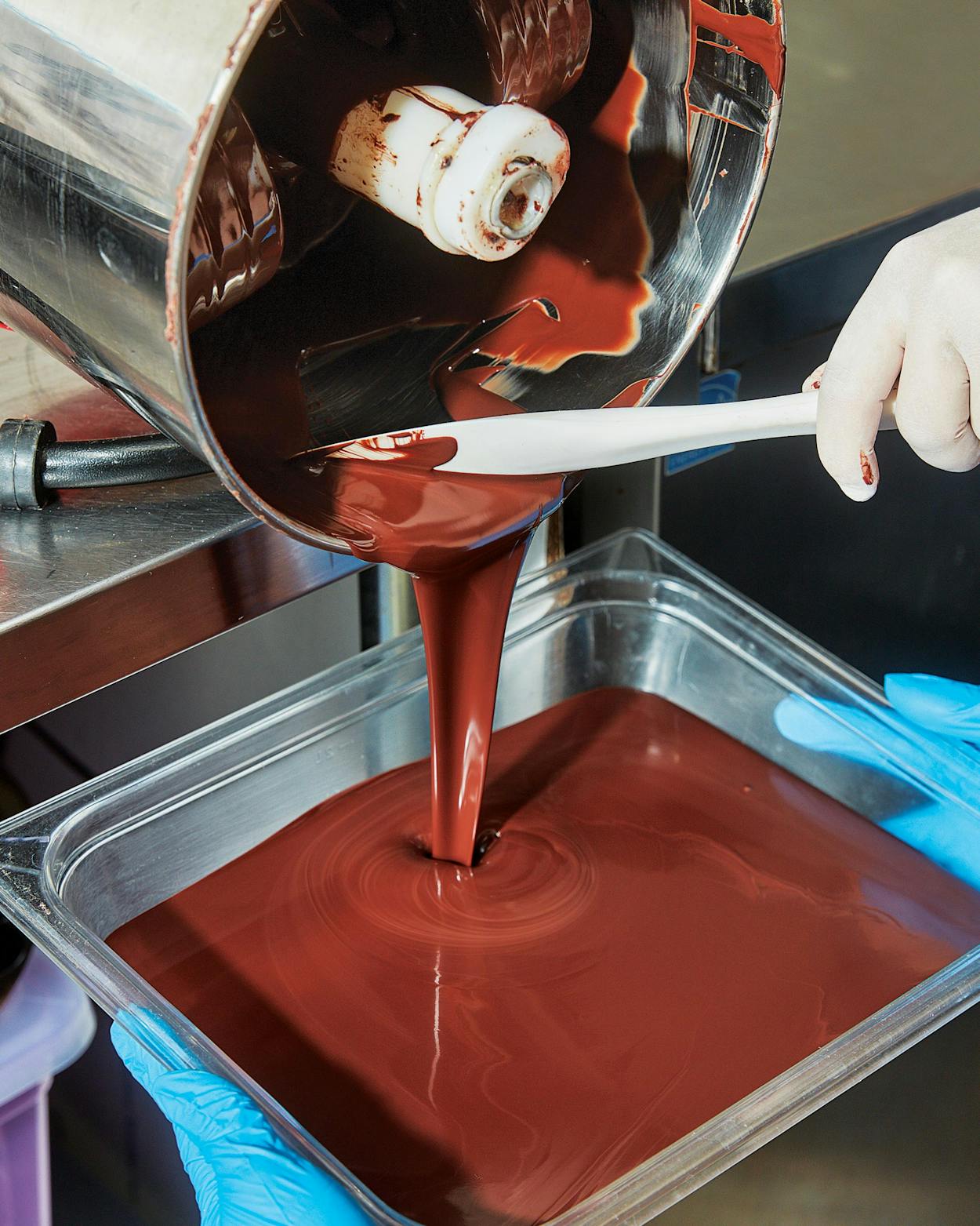Barbecue was supposed to be the side business at Tejas Chocolate Craftory when it opened in Tomball in 2015. Scott Moore Jr. and his partner, Michelle Holland, knew that chocolate alone wouldn’t pay the rent for the charming 1907 house they found for their shop in the historic Old Town district. While mulling options for additional revenue, Moore, a self-described backyard barbecue warrior, considered that this small town, about thirty miles northwest of Houston, didn’t have many good options for smoked meat. So Moore and Holland bought a smoker, added a barbecue menu, and brought in Scott’s brother, chef Greg Moore, to run the kitchen inside their chocolate store.
When Scott proposed that he join Tejas, Greg was happy to leave behind the stressful life of a restaurant chef in Houston for what he thought would be a quieter gig as a suburban pitmaster. But then, in 2017, just two years after Tejas opened, Texas Monthly listed it as the number six barbecue joint in the state. The crowds arrived for the Prime-grade brisket, smoked pork belly, pastrami beef ribs, and the now-famous carrot soufflé (Holland’s inspired creation). This called for a name change: Tejas Chocolate Craftory became Tejas Chocolate & Barbecue in 2018.
Despite all the smoked-meat adulation Tejas has received, chocolate remains Scott’s first love. A case full of chocolate truffles is still the first thing you see when you walk through the front door. “We sell barbecue to pay for our chocolate-making habit,” Scott says.
Craft chocolate and craft barbecue have a lot more in common than you might guess. Making each involves “this collision of science and chemistry with craftsmanship and artistic license,” Scott explains. That process is what drew him to chocolate when he was living a different life, selling tension-control fasteners for railroad coal cars. One night in 2009, a show on the Food Network introduced Scott to the world of bean-to-bar chocolate. He promptly ordered bars from several producers to sample; his favorite was Amano Artisan Chocolate’s Dos Rios bar, made with cocoa beans, known as cacao, from the Dominican Republic. “[It] changed my opinion about chocolate,” he recalls, still a bit breathless. Scott studied the teachings of John Nanci on the Chocolate Alchemy website, which guides users through how to make bean-to-bar chocolate at home. Within a year, Scott had all the equipment required to produce his own bars.


From day one at Tejas, the heart of the business has been single-origin chocolate bars (meaning that all of the beans come from one country). Customers prefer the truffles about five-hundred-to-one over the bars, Scott jokes, but hearing the satisfying snap of a well-tempered bar breaking (and smelling the pleasant aroma it releases) is what fuels his passion, even if he’s not as involved in the production these days. The chief chocolatier at Tejas is now Janie Williams. She joined the business after working at the local Starbucks because she wanted to learn about barbecue. It wasn’t long before she realized that she enjoyed roasting cocoa beans more than smoking meat, but the lessons for both processes had their parallels.
Just as the flavor of a finished brisket depends heavily on the quality of the raw beef, a chocolate bar’s excellence relies on the quality of the raw cocoa beans. You can’t make a spectacular bar from the commodity-grade beans used in most of the world’s chocolate. While those beans are typically mass produced in countries such as Ivory Coast, Ghana, and Indonesia, Tejas sources its premium beans from cacao farms in Belize, the Dominican Republic, Mexico, Madagascar, and Guatemala. Like a pitmaster watching the flames, Williams carefully roasts the beans in small batches, relying not on a timer but rather the aroma to know when a batch is complete.
The chocolate gets better as it ages, “like wine,” Williams says. The longer the chocolate sits, the more that flavor notes, such as berry or stone fruits, come through.
After roasting, the beans are cracked and winnowed to create nibs. The nibs are then “seasoned” as simply as a salt-and-pepper brisket, with just cocoa butter and sugar (which is why high-quality cocoa beans are so crucial). The mixture is then slowly stone-ground into a paste inside a machine called a melangeur for 120 hours. Williams forms the chocolate into large blocks that age for months or even years to develop their flavor. Chocolate gets better as it ages, “like wine,” Williams says. The longer the chocolate sits, the more that flavor notes, such as berry or stone fruits, come through. It’s a low-and-slow process.
The next step for a great chocolate bar is tempering, which is more chemistry than art. The big block of chocolate that’s been aging is brought up to 120 degrees to melt all its fat crystals; then it’s cooled to around 85 degrees before being heated again to between 90 and 92 degrees. That melts all but the beta crystals in the chocolate. Scott explains that the beta crystal, which has the highest temperature threshold, “gives the chocolate its backbone, structure, snappy texture, and glossy appearance.” A visibly cloudy bar or one that’s chalky in texture was compromised in this final step, much like a sloppily sliced brisket.
Another similarity between brisket and chocolate for Scott is the vulnerability that comes with serving up either. “You’re exposed,” he says. There’s nothing to hide the missteps that can occur at any point in either process. He thinks Tejas does both equally well, so he’s frustrated that the chocolate bars don’t get the recognition they deserve. They are also overshadowed by the truffles, which Tejas makes in Texas flavors such as Bananas Foster and Bourbon Old-Fashioned. “Truffles sell themselves, but selling chocolate bars is education-heavy,” he adds.

Paying $8 for a two-ounce bar of premium chocolate is sometimes a leap too far for customers, but what Tejas produces is nothing like a typical candy bar. Take the Valero bar, labeled as 70 percent Belizean dark chocolate. That means 70 percent of the bar is cacao and cocoa butter, while just 30 percent is sugar. Compare that with 30 percent cacao in a milk chocolate Hershey’s bar, and it’s no wonder that a Tejas bar is less sweet with a richer chocolate taste. For those seeking a milder flavor, Williams recommends the Good Life bar, which is on the darker end of milk chocolate bars but still serves as a gateway to dark chocolate, at 55 percent. Williams, who loves simple, single-origin dark chocolate, still craves a Venezuelan bar aged for two years that’s now sold out. Instead, she grabs a bar of Tejas’s Bolivian chocolate, while Scott prefers the Madagascar.
The chocolate bars from Tejas can be shipped (the winter months are best for this, thanks to the chilly weather), but for truffles such as the Campfire, made with smoked honey and marshmallows, you’ll have to go to Tomball.
As with barbecue, Scott thinks chocolate is good for any meal of the day—for a drink pairing, he suggests coffee in the morning, craft beers such as stouts and porters in the afternoon, and bourbon at night. And of course, chocolate and barbecue always go together.
This article originally appeared in the February 2021 issue of Texas Monthly with the headline “Like Barbecue, Like Chocolate.” Subscribe today.
- More About:
- Tomball









